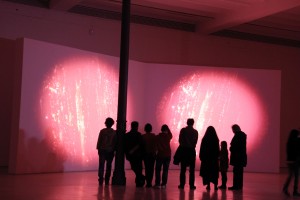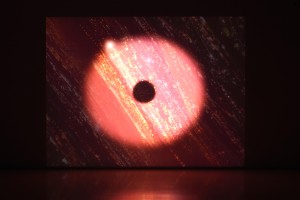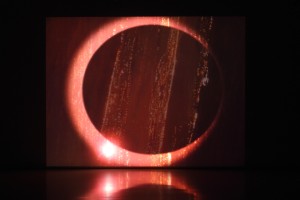Between sky and earth: Grazia Toderi’s ‘frescoes of light’ in Riga

On September 6, 2014, a first solo show of the Italian video artist Grazia Toderi in the Baltic States will open in the Floating art gallery ”NOASS” in Riga. The works retrospective will feature several large scale video projections – modern symbols of contemporary video and installation art – Black Scala (Scala Nera, 2006), Red Atlas (Atlante Rosso, 2011) and Light for K 222 (Luci per K 222, 2014) and will be on view as part of the contemporary culture forum “White Night 2014” program.
Gaining first critical attention in 1993 after participating in the 45th Venice Biennale, Grazia Toderi is often referred to as one of the most important contemporary artists, working in fields of video projection and installation art and is recognized for her iconic use of aerial images of nighttime metropolitan cities. Such works as The Trail of Angels (La pista degli angeli, 2000), Florence, Stars of Earth (Firenze, stelle di terra, 2000), Mirabilia Urbis (2001) Invisible City (Città invisibile, 2003) and London (2001) all have entered the anthology of contemporary art as the finest examples of video projections where such cities as Rome, Florence and London are explored following a viewpoint completely different from the usual one, transforming them into magical and mysterious territories, mirrored between sky and earth.
Always fascinated by the use of images taken from already existing shots and from the dynamics of spectacle (Black Scala and Light for K 222) which Grazia Toderi understands as an occasion for encounter and coming together, she works on images of stadiums, arenas and large historical theaters where imagery, appearing in continuous transformation, tackles the relationship between time, light and energy.
We met with the artist Grazia Toderi before the opening of her first solo show in Latvia to talk about the works on view, her past and future projects as well as the never fading lights of distant, mysterious and imaginary cities.


This is the first time your works, including “Black Scala” (Scala Nera, 2006), “Red Atlas” (Atlante Rosso, 2011) and “Light for K 222″ (Luci per K 222, 2014) will be exhibited in Riga, at the Floating art gallery “NOASS” and during the “White Night” contemporary culture forum. Its theme this year is inspired by Georges Méliès 1902s film “A Trip to the Moon” (Le Voyage dans la Lune) – a dreamy, surreal journey to a distant cosmic land. In your work you also often refer to mythic, far-away lands and imaginary landscapes. What attracts you the most about the idea of mythical, distant cities?
Grazia Toderi:
I’m sure that watching the television broadcast of the moon-landing (I was six year old) created my deep interest in the experience of gravity, light and video. For a child it was a strong and magic vision of technologies, a star ship traveling, mixed with a very poetic and visionary imagination about our luminous and mysterious satellite. Also a child could understand from that images that the human beings, the astronaut, could walk in an existent place, but outside the Earth, with different light, gravity, atmosphere… In 1996 I made a work with the title Born in ’63 (Nata nel ‘63), dedicated to that important experience, that was a commune experience for all my generation. Jokingly, I call it the moonlanding generation. That television moment linked together millions of people in their expectations and personal memories, perhaps, creating the first truly global collective memory.
Many of your video projections, focusing on reflecting lights and luminous cityscapes at night, were born from the images collected while traveling around the world. Have you ever worked in the Nordic or Eastern European countries, and would you consider making a work that would involve any of the cities from this region?
Grazia Toderi:
Unfortunately, I never worked in the Nordic or Eastern European countries. I’ve seen photographs of Riga which I think is a very charming city. Especially its relationship between earth, sky and water intrigues me and I would be very happy to create a work dedicated to its lights. Each city has a different timbre of light, and each landscape suggests always something unexpected…
How do you actually access and process the collected photographic images of metropolitan nightscapes?
Grazia Toderi:
Traveling and searching for my ideal perspective on the cities, I shoot hundreds of photographs during the nights, with different points of view, and different climatic situations. My dream is to have my personal archive of any city in the world and being able to look at the earth from above, losing the boundaries between nations.
I have now an archive of thousands of photos that I made of cities seen from above, and of small towns, hills, small clusters of lights in the night… For instance the video projection Red Atlas comes from the processing of many cities one on another, like in the histories of our cities, which are continually transformed, destroyed and rebuilt. Also, in 2006 I’ve made a video titled Red Babel (Rosso Babele) – a fabrication of multiple superimposed and layered urban views – and I think Babel is still the most contemporary representation of our actual cities.
You have organised many solo exhibitions in your native Italy and abroad and participated in more than hundred group shows across the globe. The video “Forget-me-not” (Notiscordardime, 1993) as well as “The Take-off“ (Il decollo,1998) and “The flower of 1001“ (Il fiore delle 1001 Notte, 1998) and “Red Orbits” (Orbite Rosse, 2009) double video projection were on show at the Venice Biennale – the world’s major contemporary art exhibition. What are your expectations for the first solo show in the Baltic States?
Grazia Toderi:
The three works – Black Scala, Red Atlas and Light for K 222 will be seen in the space of the Floating art gallery “NOASS” in Riga as in no other place in the world. I like to work with the specific idea of installation in space which often transforms the fruition of an object displayed. Moreover, I believe that an art work per se also has a great capacity of transforming itself by traveling across the world, accumulating the growth of own story and being transformed in every new show. I think this is a recent concept for many art works – they cross the history of art with own specific histories.
Many of your projects including “Red Atlas” that will be on show in Riga, have already become symbols of contemporary video art. What works are the most significant personally for you and how did they influence your recent and future projects?
Grazia Toderi:
The most significant work is always the one I am currently working on and every project is a link in a chain that leads to the next idea. They are all parts of the same chain.
Your early video works were grounded in simple everyday environment and later developed into large scale cosmic visions. In what directions your future projects will develop?
Grazia Toderi:
I really do not know. My latest video Light for K 222 is dedicated to a wonderful collection of musical instruments of Bologna. Perhaps nothing could be further away from the idea of city and traveling light, but in the end this is a single, continuous path. I look at the work and again see cities, theatres, constellations…
Contemporary video and installation art has a great ability to accommodate both tradition and futuristic technological development. In what ways the imagery of your most recent work – “Light for K 222″ – translate symbolism of the past into modern aesthetics?
Grazia Toderi:
What amazed me the most during my visits to the Museo della Musica in Bologna (ed. International Museum and Library of Bologna) was an all-embracing silence. Looking at the exposition, I could only imagine the sound that all the instruments gathered together at one space could possibly produce. Wandering through the mysterious halls of the museum I noticed an exhibition guide with a transcript of a letter from 18 December 1776 in which Padre Martini, creator of the collection and teacher of W.A. Mozart congratulates him on the good counterpoint of his Misericordias Domini K. 222.
My instrument (unlike the musical instrument) allows me to create a canto that lasts for a potentially infinite length of time, always the same, formed not of sounds but of luminous energy: projection of light. So I have transcribed the offertory K. 222 in a ring of pulsating light that can allow it to ‘sing for all eternity’. At the Museo della Musica I find myself again tackling the relationship between time, light and energy…
Your works have vast references not only to classical music, but also architecture, photography and art history. As a contemporary video artist how do you approach this duality between technological development and the great heritage of the Western civilisation?
Grazia Toderi:
For me the most important thing in video is its own material, light, that travels and meets a surface on which it manifests itself. The first light appears only in the head, then comes the drawing that fix it on paper, then the light of photography and finally the projection. Thus, the video projection can represent architecture, but at the same time become architecture itself. Just like frescoes in a church, video projections can simultaneously accommodate painting and architecture. I love cinema and architecture, but my first reference is art history.
As a contemporary artist continuously crossing stylistic, geographical and chronological boundaries, how would you describe contemporary art scene in Italy today and particularly video/installation art? What is trending and what recedes?
Grazia Toderi:
I travel a lot, and when I’m not traveling I’m closed in my study, focused on my work. The art system changed a lot in the last years, and there is a part of it that is very boring, but on the other hand there is now the wonderful possibility to have relations everywhere in the world, and this helps to forget the problems of the specific country.
about this entry
you’re currently reading “Between sky and earth: Grazia Toderi’s ‘frescoes of light’ in Riga”, an article on NOASS
- published on:
- /
- category:
- Bez tēmas



